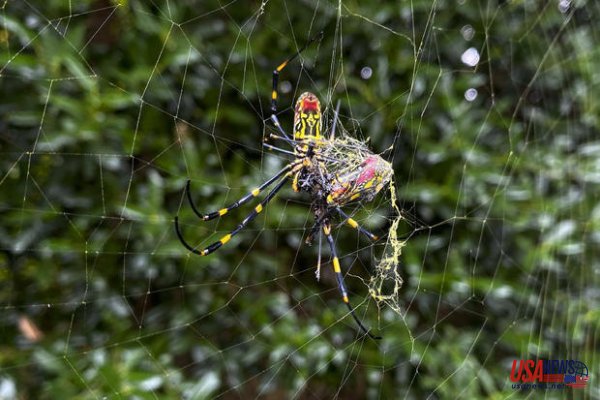An Asian-native spider has been weaving its golden web on North Georgia's power lines, porches, and vegetable patches this year. This has caused some homeowners to be unnerved and has triggered a flood of anxious social media posts.
Jennifer Turpin, a self-described Arachnophobe in metro Atlanta, stopped blowing leaves in the yard after accidentally walking into a web made by the Joro Spider. Stephen Carter avoided walking along the Chattahoochee River, where he encountered Joro spiders at every dozen steps.
On Oct. 24, 2021, the Joro spider, an Asian-native spider, was seen in Johns Creek (Georgia). ALEX SANZ / AP
Further east, in Winterville, Georgia Will Hudson's front porch was rendered unusable by a swarm of Joro spider webs that were 10 feet deep. Hudson claims that he has killed over 300 spiders from his property.
Hudson stated that last year there were many spiders and they became a problem when I was doing yardwork. "This year I have many hundred and it makes the place look creepy with all their messy webs -- almost like an episode of 'Arachnophobia'."
According to the University of Georgia , millions of large spiders have created three-dimensional webs of gold in approximately 25 countries.
The Joro Trichonephilaclavata is part of a group known as orb weaver spiders for their well-organized, wheel-shaped webs. Joro females are common in Japan, China and Korea. They have bright yellow, blue, and red markings. When their legs are extended fully, they can reach three inches in length.
It is not known how or when the first Joro Spider arrived in America. CBS affiliate WGCL TV reported that the spiders were dropped off in Georgia via a shipping container. Rick Hoebeke, Georgia Museum of Natural History, was the first to identify them in Georgia in 2014.
They were also found in South Carolina and Hudson is certain they will spread throughout the South.
Although experts are unanimous in their abundance, it is not clear why.
Paula Cushing (an arachnologist at Denver Museum of Nature & Science) said that we see natural ebbs & flows in the populations of many species. This could be related to changes in rainfall.
Christopher Brown, a Georgia Gwinnett College biology professor, said that spiders thrive in Georgia because of its similar climate to large areas of Japan -- warm and dry.
Brown stated, "I don’t believe they’re going anywhere,"
Cushing and other experts agree that Joros aren't a threat to humans, dogs or cats. They won't bite them unless they feel very threatened. Hudson stated that a researcher who collected them with her naked hands did experience a pinch but the spiders never bit her skin.
However, researchers aren't sure if the spider's impact on other species or the environment will be significant.
Debbie Gilbert, 67 years old, doesn't want to wait. She has adopted a zero tolerance policy for spiders in her Norcross, Georgia home. She strangles them with a stick and brings them down.
"I don’t advocate killing any animal. She said that she lives in peace with the spiders and all other creatures. "But (Joros), just don't belong there, that's all."
Turpin, 50, attempted to light a Joro web of Joro spiders at her East Cobb house, but she got scared that it would fall on her. She quickly backpedaled and the web fell into a hole. Instead, she had it removed by a neighbor.
She stated, "I don't believe I'm going yard work anymore."
Nancy Hinkle, an entomologist from the University of Georgia, stated that Joros are able to suppress biting flies, mosquitoes, and biting insects. They are also one of few spiders capable of catching and eating brown marmorated stink bug, which can be a serious pest to many crops.
This is amazing. This is amazing. She said spiders are our friends." "They're out there catching all the pests that we don’t want around our house."
Ann Rypstra, a Miami University researcher who studies spider behavior, was cautious about her assessment of the Jora’s potential impacts. She stated that more research was necessary.
She said, "I would always err on to the side of caution whenever something establishes itself in a place it's not supposed."
Clemson University in South Carolina was also more cautious, stating in an August factsheet that they don't know "if there will any negative impacts from the non-native species of South Carolina on the local ecology."
Naturalists and amateur gardeners have expressed concerns about the safety and well-being of native bees, spiders, and other pollinators.
Cushing stated that Joros may be large enough to take on large insects caught in their webs but are likely insignificant in terms of their diet. Rypstra studied a similar species of spider and found that their webs were used as food by other spiders. She said that Joros can also compete with other orb weavers.
Let's just say that there are many unknowns.
The majority of Joros will die in November. However, scientists believe that they could return next year in even greater numbers.
Anthony Trendl, a Suwanee homeowner, enjoys them right now. To share his passion and help others understand spiders, he has created jorospider.com. He said that although they can be scary and raise concerns, they are beautiful.
He said, "It's been rough going of things." "I wanted to see the good in this world. Nature is a great place to find it.












